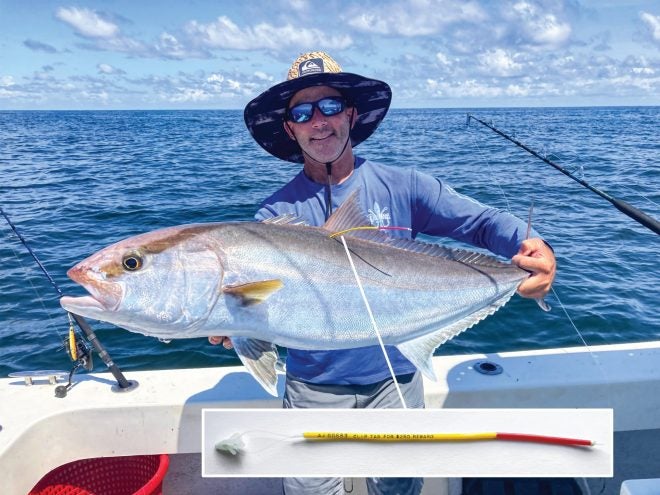Scientific Study Offering $250 for Tagged Greater Amberjack
Eugene L. 07.07.22

Anyone fishing in the Southeast Atlantic and the Gulf of Mexico has the chance to come home $250 richer for catching Greater Amberjack. The Greater Amberjack Count is well underway. So, in addition to this effort scientists are going to begin a wide-scale tagging effort this summer. This will involve two types of tags, and for anyone who captures one of these fish, you can be rewarded $250 for sending in the tag and the requested data to the research team.
“Dr. Sean Powers of the University of South Alabama is leading a “Dream Team” of researchers in an $11.7 million study of the greater amberjack species. Similar to the Great Red Snapper Count, the Greater Amberjack Count’s overarching goal is to estimate the number of greater amberjack in the U.S. South Atlantic and Gulf of Mexico, though additional objectives focus on understanding movement patterns and collecting biological information.
Funded by the National Sea Grant College Program and National Oceanic and Atmospheric Administration (NOAA) Fisheries, the project could have significant implications for commercial and recreational fishing and coastal economies supported by those industries.”
There are two types of tags being deployed on the Greater Amberjack. There will be 450 of the Greater Amberjacks equipped with an electronic acoustic tag which is surgically implanted into the body cavities of the fish. These tags emit signals unique to each tagged fish. The signals are recorded by an array of strategically placed underwater acoustic receivers or “listening stations.” These tags will be deployed throughout the U.S. South Atlantic and Gulf of Mexico from North Carolina to Texas.
The second type of tag that’s being deployed is a conventional plastic tag. They are simple, plastic-coated objects applied externally to the fish. They stick into the fish right under the skin and look like a colorful streamer. There will be 750 Greater Amberjacks tagged with the conventional tags. These tags are going to be deployed in the same geographical range as the acoustic tags as well. Some fish will have two tags on them. This is to see how often a tag pops loose off a fish over time. Also, it should be noted that all acoustically tagged Greater Amberjacks will also have conventional tags as well.
These conventional tags for this project are made to be highly visible. They have a yellow coated base near the fish body, and a red coating at the end of the tag. One side of the tag has the tag number (“AJ” followed by five digits) and instructions to clip the tag for a $250 reward. The other side has a phone number and reprinted tag number. These tags will be located on the back of each fish beneath its second dorsal fin. If the fish is double-tagged, there will be one tag on each side of the fish.
The success of this conventional tagging study critically depends on the participation of fishermen both commercially and recreationally. When you catch a conventionally tagged AJ, you should clip off the tag or tags of the fish. Then fisherman should call the phone number printed on the tag to report the recapture of the fish. In addition to the tag number(s), fishermen will be asked to provide other information, including the fishing sector, the date the fish was caught, the fish’s length and weight, and the latitude and longitude where the fish was caught. Each tagged greater amberjack, regardless if it has one or two tags, will carry a reward of $250.
Fishermen who catch the conventionally-tagged AJs besides, reporting their recapture information, must also mail in the physical tag or tags to claim their reward. Even if the fish is to be released keep the tags, and if the fish is double-tagged both tags must be clipped and sent to the research team to receive your $250 reward.
While great amberjack season is open currently in the US South Atlantic, they are currently closed in the US Gulf of Mexico for now and will reopen later this year. Fishermen in the Gulf who catch conventionally-tagged greater amberjack should still take all the measurements, collect the tags, report the information, and send back the tags. The same goes for AJs that are too small to be legally kept.
The data from the conventional tag returns and other components of the Greater Amberjack Count will be used by scientists to estimate the number of greater amberjack in the US Gulf of Mexico.
For more information about the Greater Amberjack Count, please visit https://gulfseagrant.org/reef-fish-extension/greater-amberjack-research-program/.